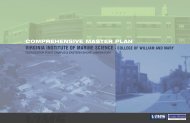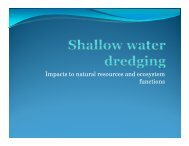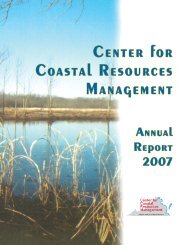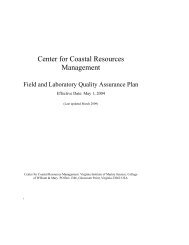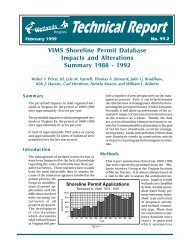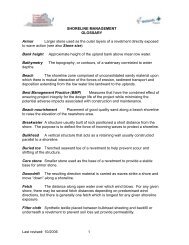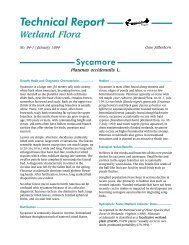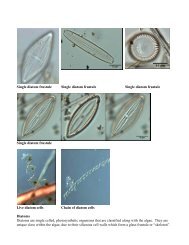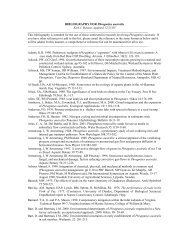Report - Center for Coastal Resources Management - Virginia ...
Report - Center for Coastal Resources Management - Virginia ...
Report - Center for Coastal Resources Management - Virginia ...
You also want an ePaper? Increase the reach of your titles
YUMPU automatically turns print PDFs into web optimized ePapers that Google loves.
Chapter 3. Applications <strong>for</strong> <strong>Management</strong><br />
3.1 Introduction<br />
There are a number of different management applications <strong>for</strong> which the<br />
Shoreline Situation <strong>Report</strong>s (SSRs) support. This section discusses four of them<br />
which are currently high profile issues within the Commonwealth or Chesapeake<br />
Bay watershed. The SSRs are data reports, and do not necessarily provide<br />
interpretation beyond the characteristics of the nearshore landscape. However,<br />
the ability to interpret and integrate these data into other programs is key to<br />
gleaming the full benefits of the product. This chapter offers some examples <strong>for</strong><br />
how data within the SSRs can be integrated and synthesized to support current<br />
state management programs.<br />
3.2 Shoreline <strong>Management</strong><br />
The first uses <strong>for</strong> SSRs were to prepare decision makers to bring about<br />
well in<strong>for</strong>med decisions regarding shoreline management. This need continues<br />
today, and perhaps with more urgency. In many areas, undisturbed shoreline<br />
miles are almost nonexistent. Development continues to encroach on remaining<br />
pristine reaches, and threatens the natural ecosystems which have prevailed. At<br />
the same time, the value of waterfront property has escalated, and the exigency<br />
to protect shorelines through stabilization has increased. Generally speaking,<br />
this has been an accepted management practice. However, protection of tidal<br />
shorelines does not occur without incidence.<br />
<strong>Management</strong> decisions must consider the current state of the shoreline,<br />
and understand what actions and processes have occurred to bring the shoreline<br />
to its current state. This includes evaluating existing management practices,<br />
assessing shore stability in an area, and determining future uses of the shore.<br />
The SSRs provide data to per<strong>for</strong>m these evaluations.<br />
Plate A defines the land use adjacent to the shoreline. To the extent<br />
that land use directs the type of management practices found, these maps can<br />
predict shoreline strategies which may be expected in the future. Residential<br />
areas are prone to shoreline alterations. Commercial areas may require structures<br />
along the shore <strong>for</strong> their daily operations. Others frequently seek structural<br />
alternatives to address shoreline stability problems. Forested riparian<br />
zones, and large tracts of grass or agricultural areas are frequently unmanaged<br />
even if chronic erosion problems exist.<br />
Stability at the shore is described in Plate B. The bank is characterized<br />
by its height, its state of erosion, and the presence or absence of natural buffers<br />
at the bank toe. Upland adjacent to high, stable banks with a stable natural<br />
buffer at the base are less prone to flooding or erosion problems resulting from<br />
storm activity. Upland adjacent to banks of lesser height (< 5feet) are at<br />
greater risk of flooding, but if banks are stable with marshes or beaches<br />
present, erosion may not be as significant a concern. Survey data reveals a<br />
strong correlation between banks of high erosion, and the absence of natural<br />
buffers. Conversely, the association between stable banks and the presence of<br />
marsh or beach is also well established. This suggests that natural buffers such<br />
as beaches and fringe marshes play an important role in bank protection. This is<br />
illustrated on the maps. Banks without natural buffers, yet classified as low<br />
erosion, are often structurally controlled with rip rap or bulkheads.<br />
Plate C delineates structures installed along the shoreline. These include<br />
erosion control structures, and structures to enhance recreational use of the<br />
waterway. This map is particularly useful <strong>for</strong> evaluating requests from property<br />
owners seeking structural methods <strong>for</strong> controlling shoreline erosion problems.<br />
Shoreline managers can evaluate the current situation of the surrounding shore<br />
including: impacts of earlier structural decisions, proximity to structures on<br />
neighboring parcels, and the vicinity to undisturbed lots. Alternative methods<br />
such as vegetative control may be evaluated by assessing the energy or fetch<br />
environment from the images. Use this plate in combination with Plate B to<br />
evaluate the condition of the bank proposed <strong>for</strong> protection.<br />
A close examination of shore conditions may suggest whether certain<br />
structural choices have been effective. Success of groin field and breakwater<br />
systems is confirmed when sediment accretion is observed. Low erosion conditions<br />
surveyed along segments with bulkheads and riprap indicate structures<br />
have controlled the erosion problem. The width of the shorezone, estimated<br />
from the background image, also speaks to the success of structures as a<br />
method of controlling erosion. A very narrow shorezone implies that as bulkheads<br />
or riprap have secured the erosion problem at the bank, they have also<br />
deflated the supply of sediment available to nourish a healthy beach. This is a<br />
typical shore response, and remains an unresolved management problem.<br />
Shoreline managers are encouraged to use all three plates together when<br />
developing management strategies or making regulatory decisions. Each plate<br />
provides important in<strong>for</strong>mation independent of the others, but collectively the<br />
plates become a more valuable management tool.<br />
3.3 Non-Point Source Targeting<br />
The identification of potential problem areas <strong>for</strong> non-point source<br />
pollution is a focal point of water quality improvement ef<strong>for</strong>ts throughout the<br />
Commonwealth. The three tiered approach provides a collection of data which,<br />
when combined, can allow <strong>for</strong> an assessment of potential non-point source<br />
pollution problems in a waterway.<br />
Grass land, which includes cultivated and pasture lands, has the highest<br />
potential <strong>for</strong> nutrient runoff. These areas are also prone to high sediment loads<br />
since the adjacent banks are seldom restored when erosion problems persist.<br />
Residential, bare, and commercial land uses also have the potential to contribute<br />
to the non-point source pollution problem due to the types of practices which<br />
prevail, and large impervious surface areas.<br />
The highest potential <strong>for</strong> non-point source pollution combines these land<br />
uses with “high” bank erosion conditions and no marsh buffer protection. The<br />
potential <strong>for</strong> non-point source pollution moderates as the condition of the bank<br />
changes from “high” bank erosion to “low” bank erosion, or with the presence<br />
or absence of stable marsh vegetation to function as a nutrient sink <strong>for</strong> runoff.<br />
Where defense structures occur in conjunction with “low” bank erosion, the<br />
structures are effectively controlling erosion at this time, and the potential <strong>for</strong><br />
non-point source pollution is reduced. If the following characteristics are<br />
delineated: low bank erosion, stable marsh buffer, riprap or bulkhead; the potential<br />
<strong>for</strong> non-point source pollution from any land use class can be lowered.<br />
At the other end of the spectrum, <strong>for</strong>ested and scrub-shrub sites do not<br />
contribute significant amounts of non-point source pollution to the receiving<br />
waterway. Forest buffers, in particular, are noted <strong>for</strong> their ability to uptake<br />
nutrients running off the upland. Forested areas with stable or defended banks,<br />
a stable fringe marsh, and a beach would have the lowest potential as a source<br />
of non-point pollution. Scrub-shrub with similar bank and buffer characteristics<br />
would also be very low.



